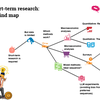Esther Kanduma
Senior Lecturer - Biochemistry at University of Nairobi | NAIROBI , Kenya
- Subjects:
- Veterinary Sciences
- Spoken languages:
- English
- Status:
- Open to collaboration.
Work
- Subjects:
- Veterinary Sciences
- Research Keywords:
- ticks and tick-borne disease, genetic diversity, population genetics, disease diagnostics, vaccines, gender studies, biochemistry, community engagement
- Collaboration interests:
- Research interests in animal parasitology focusing on ticks vectors and tickborne parasites genetic diversity & population structure, molecular diagnostics and surveillance, vaccines, translational science community engagement and women empowerment
- Biography:
- 1. Calvani, N. E. D., Verissimo, C. D. M., Cantacessi, C., Clark, E., & Kanduma, E. (2022). Herminthology: promoting gender equity in science and parasitology. Trends in Parasitology. 2. Kanduma, E. G., Mwacharo, J. M., Githaka, N. W., Kinyanjui, P. W., Njuguna, J. N., Kamau, L. M., ... & Bishop, R. P. (2016). Analyses of mitochondrial genes reveal two sympatric but genetically divergent lineages of Rhipicephalus appendiculatus in Kenya. Parasites & vectors, 9(1), 1-15. 3. Githaka NW, Kanduma EG, Wieland B, Darghouth MA, Bishop RP. (2022). Acaricide resistance in livestock ticks infesting cattle in Africa: Current status and potential mitigation strategies. Current Research in Parasitology & Vector-Borne Diseases, p.100090. 4. Githaka NW, Bishop RP, Šlapeta J, Emery D, Nguu EK, Kanduma EG. (2022). Molecular survey of Babesia parasites in Kenya: first detailed report on occurrence of Babesia bovis in cattle. Parasite & Vectors. 15(1)1-11 5. Collins M, Ngetich C, Owido M, Getange D, Harris R, Bargul JL, Bodha B, Njoroge D, Muloi D, Martins DJ, Villinger J, Githaka N, Baylis M, Fèvre EM, Kanduma E, Younan M, Bell-Sakyi L. (2022). Detection of Antibodies to Ehrlichia spp. in Dromedary Camels and Co-Grazing Sheep in Northern Kenya Using an Ehrlichia ruminantium Polyclonal Competitive ELISA. Microorganisms. 10(5): 916. 6. Lepore, C. M., Kamau, L., & Kanduma, E. 2022. Molecular Prevalence of Entamoeba Species among Diarrheal Patients in Eastern Kenya. European Journal of Biology and Biotechnology, 3(1) 39-46. 7. Githaka, Naftaly W, Kanduma, Esther G, Bishop, Richard P. (2021). Role of climate and other factors in determining the dynamics of tick and tick-transmitted pathogen populations and distribution in western, central and eastern Africa in Climate, ticks and disease. Edited by Pat Nattall . CABI 8. Nyabongo L, Odongo DO, Milton G, Machuka E, Vudriko P, Pelle R, Kanduma EG. (2021). Molecular survey of cattle ticks in Burundi: First report on the presence of the invasive Rhipicephalus microplus tick. Plos one16 (12): e0261218 9. Getange D, Bargul JL, Kanduma E, Collins M, Bodha B, Denge D, Chiuya T, Githaka N, Younan M, Fèvre EM, Bell-Sakyi L, Villinger J. (2021). Ticks and Tick-Borne Pathogens Associated with Dromedary Camels (Camelus dromedarius) in Northern Kenya. Microorganisms 9 (7): 1414 10. Nyabongo L, Kanduma EG, Bishop RP, Machuka E, Njeri A, Bimenyimana AV, Nkundwanayo C, Odongo DO, Pelle R. (2021). Prevalence of tick-transmitted pathogens in cattle reveals that Theileria parva, Babesia bigemina and Anaplasma marginale are endemic in Burundi. Parasites & Vectors. 14(1): 1-15. 11. Peter, S.G., Aboge, G.O., Kariuki, H.W., Kanduma, E.G., Gakuya, D.W., Maingi, N., Mulei, C.M. and Mainga, A.O., (2020). Molecular prevalence of emerging Anaplasma and Ehrlichia pathogens in apparently healthy dairy cattle in peri-urban Nairobi, Kenya. BMC Veterinary Research, 16(1): 1-12. 12. Kanduma, E. G., Emery, D., Githaka, N. W., Nguu, E. K., Bishop, R. P., & Šlapeta, J. (2020). Molecular evidence confirms occurrence of Rhipicephalus microplus Clade A in Kenya and sub-Saharan Africa. Parasites & Vectors, 13(1), 1-15. 13. Policy Brief (2018): Improving tick-borne diseases control in Kenya: a strategy to incorporate multiple approaches 14. Kanduma, E. G., Bishop, R. P., Githaka, N. W., Skilton, R. A., Heyne, H., & Mwacharo, J. M. (2019). Mitochondrial and nuclear multilocus phylogeny of Rhipicephalus ticks from Kenya. Molecular phylogenetics and evolution, 140, 10:65-79. 15. Triza Tonui., Pilar Corredor-Moreno., Kanduma, E.G., Joyce Njuguna., Moses N. Njahira., Steven G. Nyanjom., Joana C. Silva., Appolinaire Djikeng., Roger Pelle. (2018). Transcriptomics reveal potential vaccine antigens and a drastic increase of upregulated genes during Theileria parva development from arthropod to bovine infective stages. October 10, 2018 https://doi.org/10.1371/journal.pone.0204047. 16. Ben J. Mans., Jonathan Featherston, Marija, Kvas., Kerry-Anne, Pillay., Daniel G.de Klerk., Ronel Pienaar., et al..,, Kanduma, E.G., Nkululeko Nyangiwe., Ali Bouattour., Abdalla A. Latif. (2018). Argasid and ixodid systematics: Implications for soft tick evolution and systematics, with a new argasid species list. Ticks and Tick-borne Diseases. October 1 2018. 17. Gaston Sefu Amzati, Roger Pelle, Jean-Berckmans Bahananga Muhigwa, Kanduma, E.G., Appolinaire Djikeng….. and Tanguy Marcotty (2018). Mitochondrial phylogeography and population structure of the cattle tick Rhipicephalus appendiculatus in the African Great Lakes region. Parasites & Vectors. Parasites & Vectors, 11:329 18. Mbaringong, G.A., Nyaboga, E.N., Wang’ondu, V. and Kanduma, E., (2017). Evaluation of Selected Cassava (Manihot esculenta Crantz) Cultivars Grown in Kenya for Resistance to Bacterial Blight Disease. World Journal of Agricultural Research 5(2), pp.94-101. 19. Kanduma, E. G., Mwacharo, J. M., Mwaura, S., Njuguna, J. N., Nzuki, I., Kinyanjui, P. W & Bishop, R. P. (2016). Multi-locus genotyping reveals absence of genetic structure in field populations of the brown ear tick (Rhipicephalus appendiculatus) in Kenya. Ticks and tick-borne diseases, 7(1), 26-35. 20. Rothen, J., Githaka, N., Kanduma, E.G., Olds, C., Pflüger, V., Mwaura, S & Daubenberger, C. (2016). Matrix-assisted laser desorption/ionization time of flight mass spectrometry for comprehensive indexing of East African ixodid tick species. Parasites & Vectors, 9(1), 151. 21. Kanduma, E. G., Joram M Mwacharo, Naftaly W Githaka, Peter W Kinyanjui, Joyce N Njuguna, Lucy M Kamau, Edward K Kariuki, Stephen Mwaura, Robert A Skilton, Richard P Bishop (2016). Analyses of mitochondrial genes reveal two sympatric but genetically divergent lineages of Rhipicephalus appendiculatus in Kenya. Parasites & Vectors, 9(1), 35 22. Githaka, N., Konnai, S., Skilton, R., Kariuki, E., Kanduma, E. G., Murata, S. and Ohashi, K., (2013.) Genotypic variations in field isolates of Theileria species infecting giraffes (Giraffa camelopardalis tippelskirchi and Giraffa camelopardalis reticulata) in Kenya. Parasitology International, 62(5), pp.448-453. 23. Lorenza Beati, Jaymin Patel, Helene Lucas-Williams, Hassane Adakal, Kanduma, E.G., Enala Tembo-Mwase, Rosina Krecek, James W. Mertins, Jeffery T. Alfred, Susyn Kelly and Patrick Kelly (2012 ). Phylogeography and Demographic History of Amblyomma variegatum (Fabricius) (Acari: Ixodidae), the Tropical Bont Tick. Vector-borne and Zoonotic Diseases 12: 1- 12 24. Suzuki S, Konnai S, Okagawa T, Githaka NW, Kariuki E, Gakuya F, Kanduma E.G., Shirai T, Ikebuchi R, Ikenaka Y, Ishizuka M, Murata S, Ohashi K. (2012). Molecular cloning and characterization of Th1 and Th2 cytokines of African buffalo (Syncerus caffer). International Journal of Immunogenetics. 39(2):170-82; 25. Kanduma, E. G., Joram M. Mwacharo, Jack D. Sunter, Inosters Nzuki, Stephen Mwaura, Peter W. Kinyanjui, Michael Kibe, Heloise Heyne, Olivier Hanotte, Robert A. Skilton, Richard P. Bishop. (2012). Micro- and minisatellite-expressed sequence tag (EST) markers discriminate between populations of Rhipicephalus appendiculatus. Ticks and Tick-borne Diseases. 3 (3) 128–136 26. Tomohiro Okagawa, Satoru Konnai, Hirohisa Mekata, Naftaly Githaka, Saori Suzuki, Edward Kariuki, Francis Gakuya, Kanduma, E.G., Tatsuya Shirai, Ryoyo Ikebuchi, Yoshinori Ikenaka, Mayumi Ishizuka, Shiro Murata, Kazuhiko Ohashi. (2012). Transcriptional profiling of inflammatory cytokine genes in African buffaloes (Syncerus caffer) infected with Theileria parva. Veterinary Immunology and Immunopathology 148 (3–4): 373–379 27. Naftaly Githaka, Satoru Konnai, Edward Kariuki, Kanduma, E. G., Shiro Murata, Kazuhiko Ohashi. (2012). Molecular detection and characterization of potentially new Babesia and Theileria species/variants in wild felids from Kenya. Acta Tropica 124 (1) 71–78. 28. Kamau, L.M, Skilton, R.A., Obura, M., Mwaura, S., Odongo, D.O. Githaka, N. Kanduma, E. G, Kabiru, E. Orago, A.S.S. Musoke, A. J. Bishop, R.P. (2011). Transcriptional regulation of two very divergent gut-expressed Bm86 antigen gene homologues in the tick Rhipicephalus appendiculatus (Acari: Ixodida). Insect Molecular Biology 20(1), 105–114: 29. Cullen MM, Sam NE, Kanduma, E.G., McHugh TD, Gillespie SH. (2006). Direct detection of heteroresistance in Mycobacterium tuberculosis using molecular techniques. J Med Microbiol.55(Pt 8): 1157-8 30. Gillespie SH, Gosling RD, Uiso L, Sam NE, Kanduma, E.G., McHugh TD. (2005). The early bactericidal activity of a moxifloxacin and isoniazid combination in smear-positive pulmonary tuberculosis. J Antimicrobial Chemotherapy. 56(6): 1169-71 31. Gosling RD, Uiso LO, Sam NE, Bongard E, Kanduma, E.G., Nyindo M, Morris RW and Gillespie SH (2003). The Bactericidal activity of moxifloxacin in patients with pulmonary tuberculosis. Am JRespir Crit Care Med. 168(11): 1342-5. 32. Kanduma, E. G., Timothy D. McHugh, Stephen H. Gillespie (2003). Molecular Methods for Mycobacterium tuberculosis strain typing-Users guide. J Appl Microbio 94:781-791 33. Kanduma, E.G., Mukuria, J.C. and Mwanda, O.W., 2007. Serum total sialic acid and Hanganutziu-Deicher antibody in normals and in cancer patients. East African Medical Journal, 84(5), pp.207-214.
Social Media
To see other contact details you need to have an active task with this person
Contacting Researchers
You need to sign in to be able to send messages to other researchers. If you're already a member you can sign in here. If not you can sign up for a free account.
The above links will open in a new tab in your web browser. Once you are signed in, you can come back to this browser tab and reload it to see the contact form.



